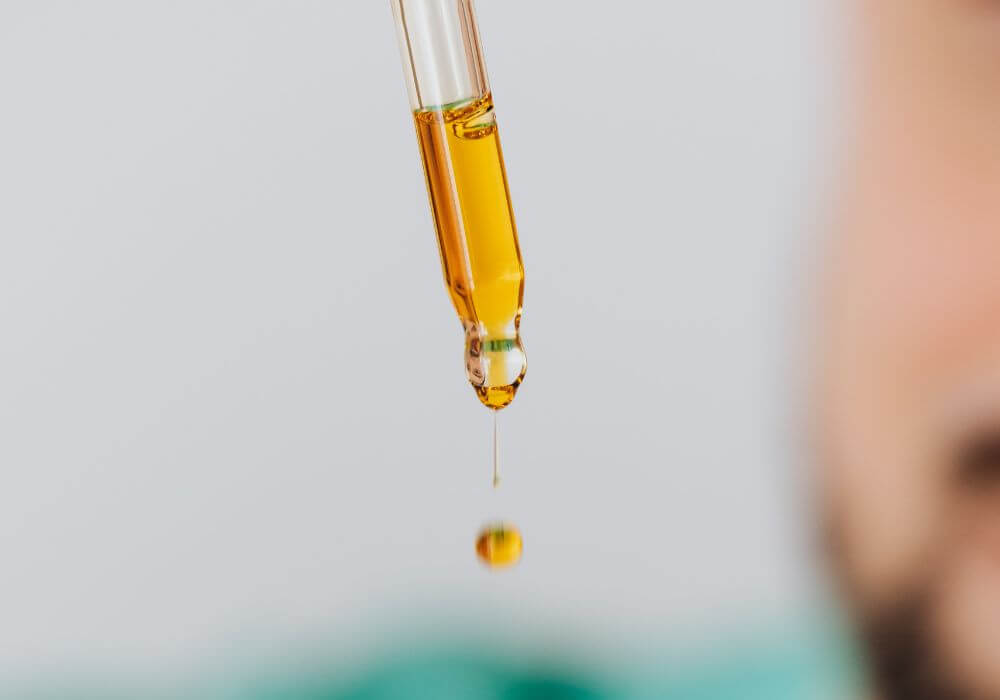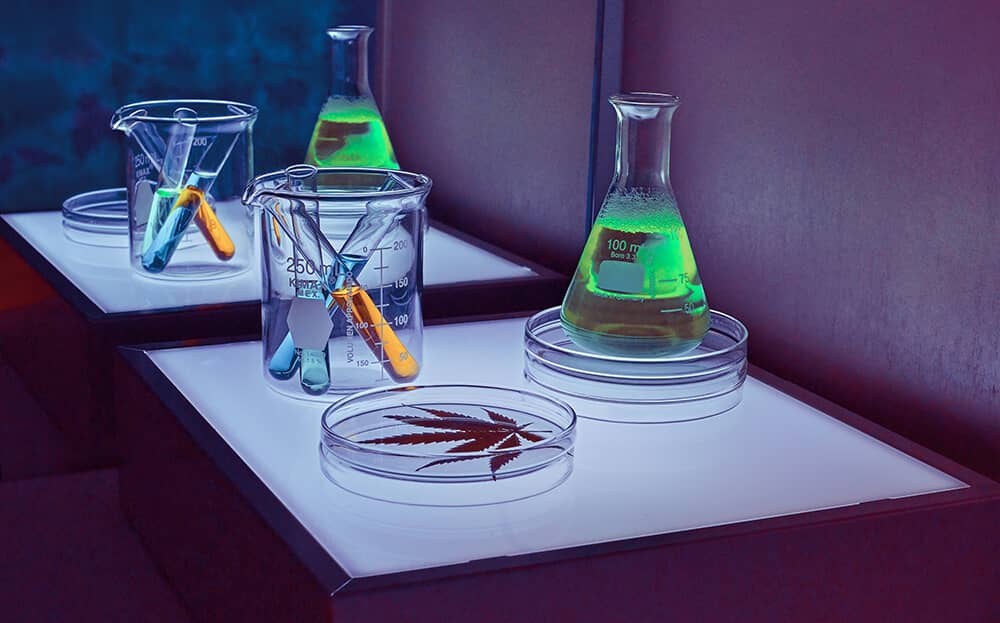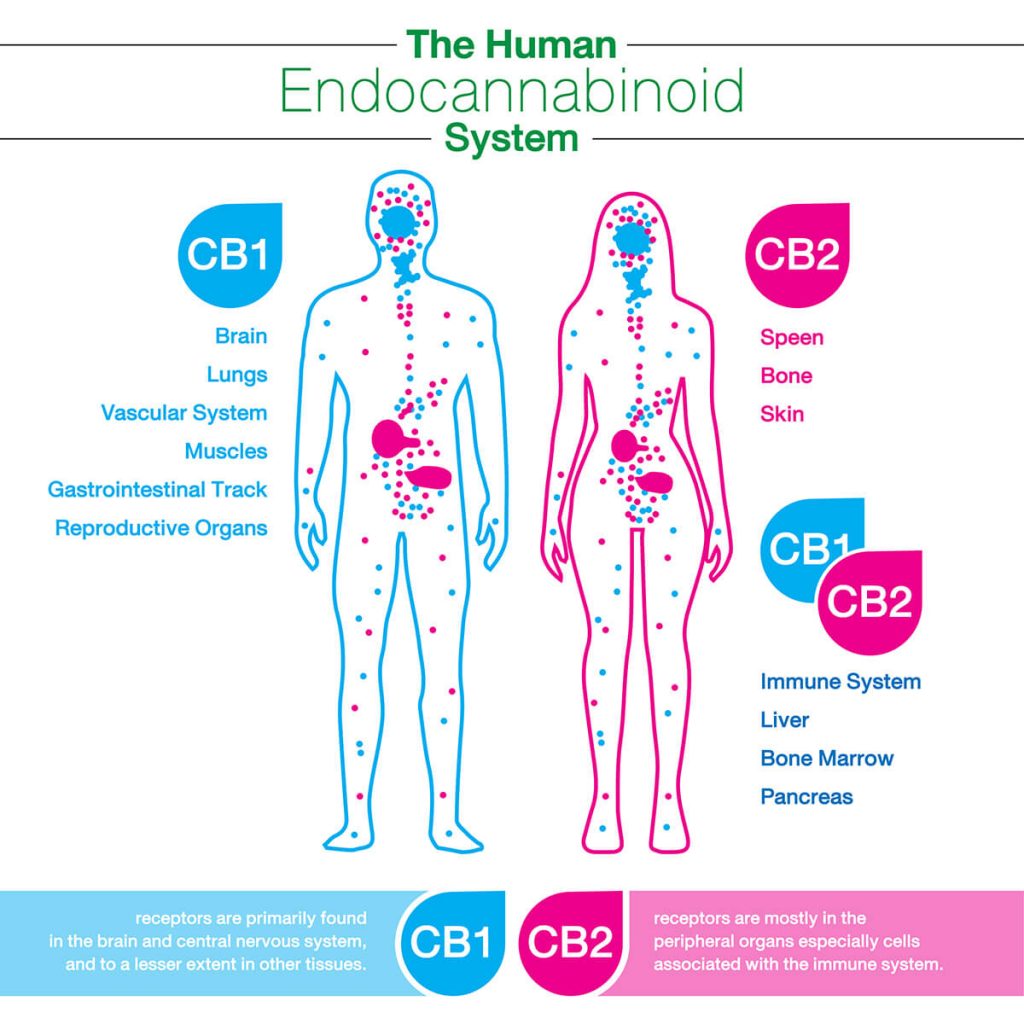A breakdown of technical jargon
If you’re interested in the health or recreational benefits that cannabis or hemp has to offer then it’s highly likely that you’ve heard of the terms THC and CBD, but what about some of the other jargon?
One of the questions we’re often asked is “what are cannabinoids, and where do they come from?“. So, in this article we’re going to help you understand what the different types of cannabinoids are, how they’re different from one another, and what they do.
What are cannabinoids?
Cannabinoids are a group of biologically active compounds found primarily in cannabis and hemp plants, alongside terpenes and phenolic compounds such as flavonoids, stilbenes, and lignans, which are also biologically active.
Biologically active compounds are compounds that have the ability to affect biological processes and impact body function, beyond their nutritional value.
This group of compounds was named after the Cannabis Sativa plant when scientists first started discovering and isolating various cannabinoids in the 1940s. Cannabinol (CBN) was the first cannabinoid to be isolated in 1940, which was followed shortly after by cannabidiol (CBD) in 1942. Tetrahydrocannabinol (THC), best known for its psychoactive effects, was discovered much later in 1964 and we now know of over 100 cannabinoids that can be found in the Cannabis Sativa plant, although THC and CBD are the most abundant, famous, and prominent cannabinoids of them all.
Learn about minor cannabinoids
Where can cannabinoids be found?
As mentioned, cannabinoids are primarily found in cannabis and hemp plants, but in the 1990s cannabinoids were also proved to be naturally occurring in the human body, and even more recently they’ve been discovered in some other plants.
Our body’s naturally occurring cannabinoids are named endogenous cannabinoids, or endocannabinoids for short. Cannabinoids from plant sources are called phytocannabinoids (phyto from the Greek word for plants) and you may also come across synthetic cannabinoids that are entirely produced in the lab.

Cannabinoids
According to the Merrium-Webster dictionary, cannabinoids can be defined as:
1: any of various naturally-occurring, biologically active, chemical constituents (such as cannabidiol or cannabinol) of hemp or cannabis including some (such as THC) that possess psychoactive properties
2: a substance that is structurally or functionally similar to cannabinoids derived from hemp or cannabis
So, when you hear the term cannabinoids, it will either be in reference to the cannabinoids found exclusively in cannabis and hemp or sometimes it may be used as an umbrella term for all types of cannabinoids, including endocannabinoids, and phytocannabinoids, because of their structural similarity to cannabinoids derived from cannabis..
In terms of cannabis cannabinoids, specifically, some cannabinoids like Delta 9 THC can be found more abundantly in medical marijuana and black market weed, where cannabis has been favored, bred, and cultivated over the years for its high THC content. CBD, on the other hand, is more prevalent in hemp, which is defined as cannabis sativa containing no more than 0.3% THC.
Over the last decade, CBD has exploded in popularity and, as research is establishing its effectiveness in relieving symptoms such as pain, sleep, nausea, and anxiety, cultivators have started breeding the CBD cannabinoid back into medical marijuana, so it’s now possible to find strains of cannabis that are high in both THC and CBD.
Over 100 other cannabinoids can also be found in both hemp and cannabis, but they are considered to be minor cannabinoids as they are present only in very small amounts. Some of the minor cannabinoids to be making headlines recently, due to their unique therapeutic potential, include CBC, CBG, Delta 8 THC, and CBN.
Phytocannabinoids (plant cannabinoids)
Phytocannabinoids are cannabinoid-like compounds from other plants. They can be described as biologically active chemical compounds found in any plant that have cannabimimetic properties, meaning they are similar to cannabinoids via their interaction with the endocannabinoid system and/or their chemical structure.
Phytocannabinoids have been discovered in plant sources outside of cannabis, including echinacea, rhododendron, and black truffles, the most famous of which are lipophilic alkylamides that can be found in the echinacea genus.
Lipophilic alkylamides are structurally similar to the cannabinoids found in cannabis and hemp and preclinical evidence has shown that they interact with our endocannabinoid system in a similar way to CBD.

Endocannabinoids (endogenous cannabinoids)
Endocannabinoids are also chemically similar to cannabinoids, but are naturally occurring in the brains and bodies of all mammalian species. Like serotonin, dopamine, and glutamate, endocannabinoids are neurotransmitters that carry messages around the brain and body. And just like serotonin interacts with serotonin receptors, endocannabinoids interact with endocannabinoid receptors around the body.
Together, these endocannabinoids and endocannabinoid receptors make up our body’s endocannabinoid system, along with metabolic enzymes that are responsible for recycling the endocannabinoids after they’ve completed their function (more on this below).
Synthetic Cannabinoids
Synthetic cannabinoids were first developed to aid research, so that scientists could learn more about cannabinoid receptors and the endocannabinoid system, but they moved from the lab to the drug scene after being described in a research paper.
Synthetic cannabinoids are a class of man-made designer drug molecules that bind to the same receptors as other cannabinoids, thereby interacting with our body’s endocannabinoid system. However, truly synthetic cannabinoids do not exist in nature and can be highly toxic and dangerous to your health..
Synthetic cannabinoids are usually designed to act most similarly to THC, acting as agonists at the CB1 receptor. Compounds like THC and synthetic cannabinoids, that bind to our CB1 receptors, will make us feel intoxicated when ingested.
Synthetic cannabinoids, also known as Spice, K2, or synthetic cannabis, are usually sprayed onto organic matter for smoking purposes, despite being labeled as “not for human consumption” in order for retailers to avoid liability.
People who do smoke synthetic cannabinoid products may experience a rapidly increased heart rate, vomiting, agitation, confusions, and hallucinations, among other symptoms. Many people smoking “fake weed” have had to seek help from emergency services and have ended up in intensive care units.

Semi-synthetic cannabinoids
Other cannabinoids may also be created in labs, such as synthetic phytocannabinoids of synthetic endocannabinoids, but they aren’t considered to be truly synthetic as they do exist in nature. Delta 8 is an example of a semi-synthetic cannabinoid because it can be found naturally occurring in cannabis and hemp, but it only appears in the plants in very small amounts, so is usually created in a lab from other cannabinoids for commercial purposes..
A brief introduction to the endocannabinoid system
Having discovered cannabinoids and knowing that they have the ability to have a profound effect on us, scientists had an inkling that we must have receptors that respond to these cannabinoids. And based on that assumption, if we have receptors, then we must also produce our own cannabinoid-like compounds in order for those receptors to exist.
Following decades of cannabinoid research, the existence of the endocannabinoid system (ECS) was finally established in 1992.
The endocannabinoid system is a unique chemical signaling network that is responsible for our bodies achieving and maintaining a state of homeostasis. It is in charge of regulating a wide range of physiological and cognitive processes in the brain and body.
Scientists have discovered two different types of cannabinoid receptor, cannabinoid type-1 receptors and cannabinoid type-2 receptors. The abundance and location of these receptors is important as it dictates how they are able to cast such a wide net of influence.
More about the endocannabinoid system
CB1 receptors
CB1 receptors are primarily concentrated throughout the central nervous system in our brains, but can be found elsewhere in our bodies, including our lungs, gut, liver, kidneys, and skin. CB1 receptor regulation is able to exert influence over processes such as pain perception, appetite, mood, stress response, memory, glucose metabolism, fertility, and sleep.
Scientists have discovered that humans have more CB1 receptors in their brains than any other type of receptor.
CB2 receptors
CB2 receptors are primarily found throughout our bodies, in our peripheral nervous system, immune system, and metabolic tissues, as well as many of our internal organs and skin. CB2 receptors help to regulate or balance immune function and inflammatory response, among other things.
So, as your external environment changes, the ECS keeps your body’s internal processes stable, whether it’s responding to a change physically, such as temperature, or a change mentally. For example, in a stressful or upsetting situation, the ECS helps maintain neuroplasticity to reduce the risk of anxiety and depression.
You can learn more about the endocannabinoid system here, but you can probably already see just how important the endocannabinoid system is to our overall health and wellness. If something in your endocannabinoid system is out of whack, it could manifest itself in a vast number of ways because it’s integral to so many processes.
This is why many scientists are starting to believe that deficiencies in the endocannabinoid system could be at the root of many, if not all, human diseases.

What do cannabinoids do?
Within the cannabis plant, cannabinoids actually have several important roles including protection against UV light and desiccation, as well as plant defense.
Both THCA and CBGA (the acidic precursors to THC and CBG) have insecticidal properties to deter pests. Cannabinoids also have herbicidal properties and are responsible for pruning lower leaves on the plant so that more energy can be directed to fertilization and producing seeds.
Endogenous cannabinoids are the signaling molecules that bind or interact with our cannabinoid receptors when threats to our biological balance arise, to help maintain homeostasis. So, endocannabinoids are produced on demand as and when they’re needed to interact with the ECS and trigger a cascade of signals that help our brains and bodies function optimally.
Endogenous cannabinoids are the only neurotransmitters in our bodies that travel backwards, from the postsynaptic nerve to the presynaptic nerve, to inhibit or encourage the actions of other neurotransmitters and receptors.
Deficiencies can arise within the endocannabinoid system due to poor diet, lack of exercise, and there are also some medications that are thought to disrupt the ECS. Clinical endocannabinoid deficiency may also occur if your body is unable to produce enough endocannabinoids, endocannabinoid receptors, or is producing too many metabolic enzymes that are recycling your endocannabinoids too quickly.
If phytocannabinoids are able to communicate with our ECS in similar ways to endocannabinoids, then it makes sense that supplementing our diets with phytocannabinoids can benefit our health in many ways.

Frequently asked questions
What are cannabinoids and terpenes?
You hear the terms cannabinoids and terpenes being used more and more frequently these days, as an increasing number of people strive to educate themselves about the potential health benefits of cannabis and hemp.
Cannabinoids are those compounds that interact with our body’s endocannabinoid system, while terpenes are the essential oils of plants, responsible for the way plants smell and taste. Like cannabinoids, terpenes have also been shown to possess unique therapeutic properties, but unlike cannabinoids, terpenes are found abundantly throughout nature.
The terpene linalool, for example, which can also be found in lavender and basil, is very good for relaxing, helping to alleviate stress and anxiety and boost mood. The terpene beta-caryophyllene, which can be found in black pepper and cloves, is an excellent anti-inflammatory and antioxidant.
it’s widely believed that cannabinoids, terpenes, and phenolic compounds, work together synergistically, able to elicit enhanced effects when administered together than when they’re alone, in a phenomenon known as the entourage effect. This is why full-spectrum or whole plant extracts are often preferred over isolated compounds.
What is the difference between cannabinoids and phytocannabinoids?
The term cannabinoids usually applies to the group of compounds found in cannabis and hemp, that are able to interact with endocannabinoid system. The term phytocannabinoids, on the other hand, refers to cannabinoid-like compounds that can be found in other plant sources.
However, they’re often used interchangeably as cannabinoids are technically also phytocannabinoids because they are derived from plants. And phytocannabinoids are technically cannabinoids, at least according the Merrium-Webster dictionary definition, which defines a cannabinoid as any compound that is structurally or functionally similar to a cannabis cannabinoid.
Summary
Now you know what cannabinoids are, perhaps it’s time to learn more about the effects of cannabinoids?
The popularity of the major cannabinoids (THC and CBD) show no signs of slowing down. People are using cannabinoids to help manage a myriad of conditions from chronic pain to mental health difficulties, such as stress, anxiety, and depression, due to their ability to interact with our body’s endocannabinoid system.
Some people even take CBD, as well as other cannabinoids, to simply improve their overall health and wellbeing and most agree that cannabinoid supplementation boosts their mood and overall feelings of contentment. Do you have any other questions about cannabinoids? Leave us a comment below and we’ll do our best to answer as quickly as possible.
